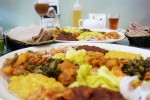To highlight the delicious perks of her vegan lifestyle, Daily Bruin staffer Alejandra Reyes-Velarde showcases 10 diverse vegan restaurants in the West Los Angeles area. She will be joined by Daily Bruin staffer William Thorne to bring a meat-eating perspective to vegan cuisine. They will alternate reviewing a restaurant each week.
I have a confession to make. I sometimes eat burgers with a knife and fork.
It’s a terrible crime, and one which labels me as a British foreigner in the United States.
It’s not that I never eat with my fingers; even I can see that eating a sandwich with a fork is impractical, but there’s something pleasing about the weight of cutlery in my hands and knowing that my fingers won’t be too greasy afterwards. Plus my British sensibility and boarding school manners dominate most of my eating practices.
However, when I ventured to Rahel Ethiopian Vegan Cuisine, I was left with no choice. I had to get my hands dirty.
I had no idea that a place called Little Ethiopia exists in Los Angeles. For one block on Fairfax Avenue, the sidewalks are lined with Ethiopian restaurants, bars and thrift stores, all bearing the flashy green, yellow and red Ethiopian flag. The block has a market feel to it, with racks of dresses for sale and outdoor tables packed with local patrons.
Among the bustle of Little Ethiopia, an airy, spacious restaurant, Rahel Ethiopian Vegan Cuisine, calls itself “the only 100 percent vegan Ethiopian restaurant anywhere.” I can’t imagine it has much competition for this title.
I had never eaten Ethiopian food before and had no idea what to expect, so I let Alejandra order for me, as she had eaten Ethiopian food before. She decided on the Millennium Special for two, a vegan feast of lentils, peas and salads.
During the long wait for our food, I cast my eyes around the restaurant and noticed a group was eating in a large, wooden hut squeezed into one corner. Inside was a collection of chairs circling a patterned injera basket, a traditional handmade table. Above the hut, a collection of gently rotating green umbrellas was suspended upside down from the ceiling.
The decor was enough to distract me for a short portion of the 40 minutes it took for our food to arrive, but when the server laid down two massive plates laden with food, all was forgiven.
The Millennium Special was the most colorful plate of food I had ever seen. A combination of split pea and lentil stews, string beans mixed with carrots, broad beans paste, stuffed green peppers, tomato salad and potatoes mixed with cabbage sat on top of the large, pancake-like injera flatbread which spilled off the plate.
I had no idea how to begin eating it. There were no cutlery or plates laid out on the table, but Alejandra showed me the way. She tore a piece of injera from a small basket, placed it on top of one of the stews and proceeded to grab a small portion of the stew using the small piece of bread as a wrapping instrument.
At first I was hesitant to follow suit. I didn’t really know what was in most of the sauces and my instincts were telling me to ask for a knife and fork. However, as Alejandra continued to tuck in, the fear of embarrassing myself overrode my British habits and I too tore off a piece of injera and rolled myself a miniature lentil pancake.
The meal felt like a celebration of the marriage between vegan and Ethiopian food, but, as a meat-eater, I had unwittingly crashed the wedding.
The stews proved rich and filling, and balanced perfectly with the fresh tomato salad. The carrots and beans were sweet and delicious, and while one type of cabbage was spicy and similar to kimchi, the other was slightly too bitter for my taste.
However, the wedding wasn’t an entire success. Scattered among the piles of stews and vegetables, two little mounds of soggy bread stood out like a sore thumb. I discovered they were small pieces of injera, dipped in various spiced sauces. I was left confused as to why we had to have soggy injera on top of dry injera. It felt like a drunk uncle had nearly spoiled the wedding.
Despite the minor soggy disappointment, my journey to Little Ethiopia introduced me to an entirely new cuisine. Part of the point of embarking on my vegan ventures was to take me out of my culinary comfort zone, and Rahel Ethiopian Vegan Cuisine with its lentil stews and injera did just that.

The marriage between vegan and Ethiopian food??? What does it’s supposed to mean?
Sorry to disappoint you those injera pieces dipped in the sauce is called firfir and it’s a dish of it’s own, not a fault as you explained it to be. Eating vegan in Ethiopian has been practiced for thousands of years due to religious and caltural reasons. Majority of Christian Ethiopians eat strictly vegan 230 days of the year, so there is no such thing as a marriage between vegan and Ethiopian food!